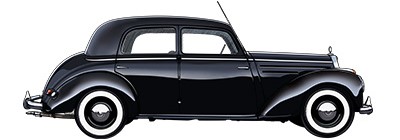The Sedan model - the history of a sedan.
Sedan is not only a city in France, but sedan also refers to a notchback sedan in American English. Perhaps you now have the image of a staircase in mind? You are absolutely right! Hop in, we'll take you on a journey through the history and evolution of this particular body type.
Body of a notchback
The body of a sedan with a notchback is quite comparable to that of steps. You can imagine the design of a notchback sedan in the rear part of the car like the course of a staircase. Starting from the roof, the rear part of the car runs downwards in steps - depending on the shape of the bumper, three steps are formed in the rear part of the car.
construction Sedan before the Second World War
Originally, the term sedan dates back to the 17th century. At that time, closed boxes with windows, in which people sat and were transported, were called sedan chair. This transport box was usually carried by two other people on the extended beams as a sedan chair.
In the pre-war period there was not yet the typical sedan as a vehicle type as we know it today. At that time, closed vehicles were dominated by an almost vertically sloping, usually outwardly curved rear line, which extended from the roof to the bumper. Similar in shape to a French coach, which you may have seen in history books. Since there was no real trunk yet, luggage was usually attached to the outside of the sedan.
The development of the Sedan after the Second World War
Further development of the notchback, or sedan, started after World War II. Meanwhile, the luggage of the trunk was stored in the interior of the vehicle, clearly separated from the passenger compartment. The new three-box design emerges.
The different design types of vehicles
In English, there are three different designs:
-
One-Box Design
The One-Box Design ecan be recognized by the fact that the A-pillar of a vehicle is placed further forward, thus combining the engine, cabin and cargo compartments (into one box). -
Two-Box Design
In a two-box design, the engine compartment is clearly separated from the passenger and cargo areas. Thus, there are two boxes into which the vehicle is divided. -
Three-Box Design
As the name suggests, the three-box design has three boxes, or areas. The engine, cab and cargo compartments are separate in this vehicle concept.
Today's sedan is defined as a closed car that is divided into three sections: one for the engine, one for the passengers, and one for the cargo (trunk). Consequently, a sedan has a three-box design.
The Sedan, more than just a notchback sedan
The notchback is defined as one of three characteristic designs (main shapes) of a sedan that have evolved over the years:
- Notchback
- hatchback
- hatchback
In addition to their appearance, the various rear-end shapes differ in aerodynamic, technical and functional characteristics. What is in the rear? As a rule, the trunk is located there - according to the vehicle design with different volumes - the exception are cars with rear-wheel drive, which, however, are numerically in the minority.
The evolution of the sedan
These small sedans or sedans were very popular, especially in Europe. Throughout history, countless new models of the sedan have emerged. Depending on the brand and manufacturer, there are different cars with different engines on the market today. From gasoline engines to e-engines, everything is now available. However, a sedan or notchback sedan is always recognized by the step-like demarcation to the trunk - the notchback.
Mercedes Sedan
Mercedes-Benz has already developed a great many different types of vehicles. From convertibles to SUVs to station wagon models. However, as a classic notchback sedan counts, for example, the C-Class from Mercedes-Benz. In recent years, these more compact sedans have become increasingly popular and so more new vehicle models have been developed.




